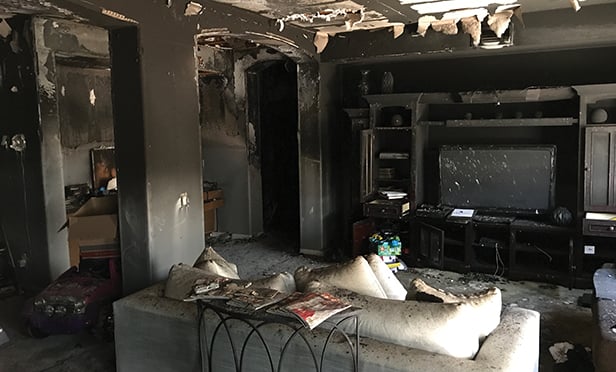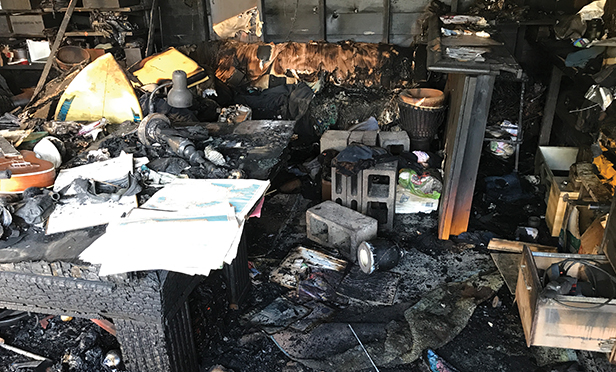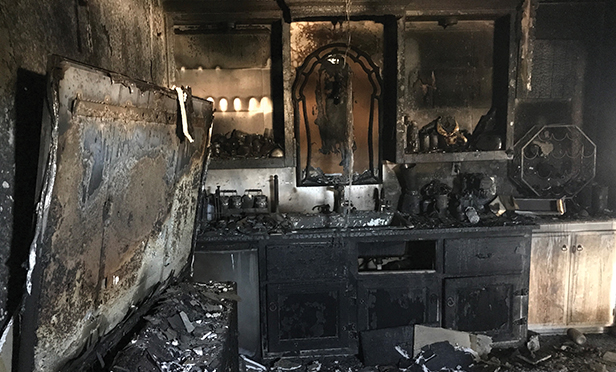Playing with fire: Avoiding toxic exposures in structure fires
Poor ventilation and a build-up of toxic substances pose risks for adjusters.
By Sean Scott | August 08, 2018
 Even though the flames are out after a fire, a number of toxic substances remain that can be hazardous to an adjuster’s health. (Photo: Sean Scott)
Even though the flames are out after a fire, a number of toxic substances remain that can be hazardous to an adjuster’s health. (Photo: Sean Scott) When property claims adjusters are assigned a fire loss, they are often on scene within hours of the fire being extinguished. The claims process typically begins with the adjuster meeting with the insured, taking photos of the damage, sketching the building layout, writing a repair estimate, compiling an inventory of lost or damaged personal property, and other tasks. This requires adjusters to spend hours and sometimes days walking amongst the ash and fire debris. However, what insurance professionals may not realize is that entering a fire-damaged structure, especially one that has recently been boarded up, can pose a serious health risk.
Although the flames are out, the smoke has cleared, and the fire department has removed the yellow tape, the fire scene is not as safe as one might think. Toxic volatile organic compounds (VOCs) created by the vast array of materials and products, that burned are in a state of off-gassing, saturating the indoor air with poisonous gases and particulates.
Related: Additional Living Expenses: Just how much is covered?
Beware of toxic substances
The combination of the lack of ventilation after a board-up and the toxicity of the combustion byproducts, classifies this environment as immediately dangerous to life and health (IDLH). The National Institute for Occupational Safety and Health (NIOSH) states that a respiratory hazard exists when a toxic contaminant is present in the air at a sufficient concentration to cause harm when inhaled. The damage may occur immediately, or it may take days, weeks, months or years for effects to surface.
The types and quantities of materials and products that combust, their chemical reactions, heat, time and other factors make each post-fire environment unique. The vast array of toxic chemicals, VOCs and particulates are limitless, and exposure to them by inhalation, ingestion or absorption through the skin can have immediate or long-term health effects. Fire investigators know all too well the dangers of post-fire environments and many have been sickened or died from exposure to fire toxins.
One example of this occurred when a fire chief in California walked through a residential fire to assess the damage. A short time later, as he was returning to the fire station, he became ill and his aide transported him to a local hospital. The hazardous material response team was called to the scene and located several glass containers of a substance later identified as liquid sodium cyanide. The chief was transported to a medical facility equipped with a hyperbaric chamber for treatment and fully recovered. Physicians and investigators eventually determined that he had inhaled near-lethal doses of sodium cyanide from a jewelry refinishing business operating from the home.
Insurance adjusters face similar health risks in structure fire settings, where they are exposed to the same toxic chemicals as firefighters and fire investigators. Here adjusters encounter residues, VOCs, and particulates from all sorts of solvents, acids, chemicals used to manufacture illicit drugs, pesticides, automotive fluids, sewage, bloodborne pathogens, mold, asbestos, lead dust and a host of other toxic materials.
Adjusters often come in direct skin contact with toxin-laden soot and ash when they cut carpet samples for value analysis or handle contents during the inventory process. However, the problem doesn’t end there. To make matters worse, smoke odor, particulates, soot and ash get on clothing, skin, hair and shoes, and are transferred to cars, offices and homes. This also exposes coworkers and family members to the same chemicals and associated health risks.
Smoke, toxic gasses and chemicals
Considering that cigarette smoke alone contains over 7,000 chemicals, with 70 identified as cancer-causing, the products and materials that burn in a structure fire produce innumerable toxins.
Currently, the EPA has over 85,000 chemicals registered in its inventory of substances that fall under the Toxic Substances Control Act and approximately 2,000 new chemicals are introduced each year. The Chemical Abstracts Service is the world’s authority on chemical information and it has over 100 million registered chemical substances in its registry. These chemicals are combined in more than 7,000,000 mixture formulations found in homes and buildings across the U.S. The majority of the chemicals currently in commercial use have not been evaluated.
Some of the most toxic chemicals and gasses found in smoke include: hydrogen cyanide, phosgene, dioxins, furans, sulfur dioxide, PCBs, hydrochloric and sulfuric acid, and arsenic. Other toxins may include benzene, lead, chromium, and other metals, toluene, acrolein, mercury, formaldehyde, phenol, styrene and polycyclic aromatic hydrocarbons.
To illustrate how toxic some of these chemicals are, phosgene and hydrogen cyanide were used in World War I as chemical warfare agents, resulting in thousands of casualties. Structure fire smoke frequently contains both of these chemicals.
 Dioxins are extremely toxic and can be formed when products such as plastic and carpeting burn. (Photo: Sean Scott)
Dioxins are extremely toxic and can be formed when products such as plastic and carpeting burn. (Photo: Sean Scott) Dioxins – the worst of the worst
Insurance adjusters are well aware of hazardous materials such as asbestos, lead and mold, but few realize how toxic smoke particulates and soot can be depending on what burned in the fire. Dioxins, especially 2,3,7,8-tetrachlorodibenzo-p-dioxin (TCDD) have been called the most toxic man-made compounds on Earth. Scientists say only radioactive waste exceeds it in toxicity. Dioxins form when products containing carbon and chlorine burn such as plastics containing PVC, electrical wire, carpeting, plastic containers, toys and thousands of everyday products.
Certain dioxin-like polychlorinated biphenyls (PCBs) with similar toxic properties are also included under the term dioxins. A characterization by the National Institute of Standards and Technology of cancer-causing potential evaluated dioxin as over 10,000 times more potent than the next highest chemical (diethanol amine), half a million times more than arsenic and a million or more times greater than all others. TCDD has also been extensively studied for health effects linked to its presence as an ingredient in Agent Orange, which was used as a defoliant during the Vietnam War.
Even in picograms (parts per trillion) dioxin is associated with severe health damage that can shorten the lives of people exposed to it, and potentially that of their offspring and future generations. The genetic effects may skip a generation and reappear in subsequent generations. Ingesting dioxins can also result in congenital malformations and a slow wasting syndrome followed by death similar to the AIDS syndrome. It is strongly suspected of contributing to the pathology of the urinary and hematological systems, growths in the colon, gall bladder complications, multiple myeloma, and lung, larynx and prostate cancer.
According to researcher Joe Thornton, “Dioxin’s health effects include endocrine disruption, reproductive impairment, infertility, birth defects, impaired neurological development, damage to the kidneys, and metabolic dysfunction…There is no evidence that there is a safe level of dioxin exposure below which none of these effects will occur…” Dioxins are tied to a large number of diseases because they intensify cancers, which other toxins initiate.
Particulate exposure
Particle exposure leads to around 20,000 premature deaths in America each year. Inhaled particles that are less than 5 microns travel to the lower lung where the gas exchange occurs in the alveoli. The particle size of soot is approximately 2.5 microns or less. To offer some perspective on the size of these particles, a red blood cell is approximately 7 microns in size.
The smallest ultrafine particles are so minute that they behave like gases, passing through the lungs and directly into the bloodstream. Ultrafine particles also travel up through the nose and, rather than passing down into the lungs, are delivered directly into the brain and central nervous system via the olfactory nerve, bypassing the body’s protective blood/brain barrier. Once in the bloodstream, these particles carry toxins around the body where they promote inflammation, disease and even death.
 Adjusters entering a burned environment should wear PPE, ventilate enclosed areas and seek medical attention immediately if they experience any adverse health issues. (Photo: Sean Scott)
Adjusters entering a burned environment should wear PPE, ventilate enclosed areas and seek medical attention immediately if they experience any adverse health issues. (Photo: Sean Scott) Safety considerations
The importance of wearing proper protective equipment when working in or around fire debris or a fire-damaged structure cannot be understated. Insurance adjusters should take proper measures to protect themselves and never underestimate the dangers of structure fire smoke, soot, ash or VOCs. Consider the following safety tips:
- Wear the highest level of respiratory, eye, skin and body protection.
- Get fit tested to ensure respirators function properly.
- Conduct air and VOC sampling to determine what types and quantities of hazardous chemicals may be present. (See OSHA Regulation 1910.134(d)(1)(iii)
- Ventilate enclosed areas unless doing so will expose others to health hazards.
- If an adjuster experiences any adverse health symptoms from exposure to smoke odors or soot, immediately seek medical attention.
Claims adjusters encounter a wide variety of hazards in the course of their jobs, but being aware of them and taking steps to mitigate the risks can help keep everyone safer.
